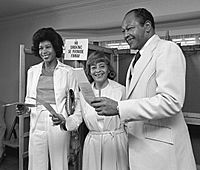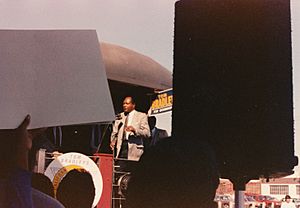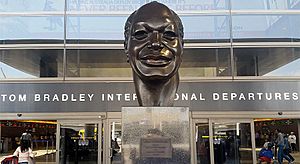Tom Bradley (American politician) facts for kids
Quick facts for kids
Tom Bradley
|
|
|---|---|
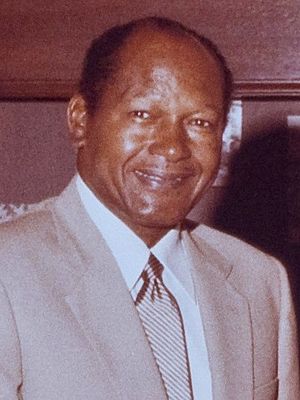 |
|
| 38th Mayor of Los Angeles | |
| In office July 1, 1973 – July 1, 1993 |
|
| Preceded by | Sam Yorty |
| Succeeded by | Richard Riordan |
| Member of the Los Angeles City Council from the 10th district |
|
| In office 1963–1973 |
|
| Preceded by | Joe E. Hollingsworth |
| Succeeded by | David S. Cunningham Jr. |
| Personal details | |
| Born |
Thomas Bradley
December 29, 1917 Calvert, Texas, U.S. |
| Died | September 29, 1998 (aged 80) Los Angeles, California, U.S. |
| Resting place | Inglewood Park Cemetery |
| Political party | Democratic |
| Spouse |
Ethel Arnold
(m. 1941) |
| Children | 2 |
| Education | University of California, Los Angeles (BA) Southwestern Law School (JD) |
Thomas Bradley (December 29, 1917 – September 29, 1998) was an important American politician. He was also a police officer. He served as the 38th Mayor of Los Angeles for 20 years, from 1973 to 1993. This was the longest time any mayor has served in Los Angeles.
Tom Bradley was the first black mayor of Los Angeles. He was also the second black mayor of a major U.S. city. He was a member of the Democratic Party. He ran for Governor of California twice but did not win. His close loss in 1982 led to the term "the Bradley effect". This term describes when voters say they will vote for a black candidate but then vote for a white one. In 1985, he received the Spingarn Medal from the NAACP.
Contents
Early Life and School Days
Tom Bradley was born on December 29, 1917, in Calvert, Texas. His family were poor farmers. They moved to Los Angeles in 1924 during the Great Migration. This was a time when many African Americans moved from the Southern U.S. to other parts of the country.
Bradley went to Rosemont Elementary and Lafayette Junior High. He then attended Polytechnic High School. There, he was the first black student to lead the Boys League. He was also the first black student in the Ephebians honor society. He was captain of the track team. He was also an all-city football player. In 1937, he went to UCLA on a sports scholarship.
Becoming a Police Officer and Lawyer
In 1940, Tom Bradley left college to join the Los Angeles Police Department. He was one of about 400 black officers in a police force of 4,000. At that time, black officers faced many challenges. They could only work in certain areas. They could not work with white officers until 1964.
Bradley married Ethel Arnold on May 4, 1941. They met at the New Hope Baptist Church. They had two daughters. While working as a police officer, Bradley also studied law. He went to Southwestern University Law School. After leaving the police department, he became a lawyer. Later, after being mayor, he worked for a law firm. He focused on international trade.
Joining the City Council
Tom Bradley started his political journey by leading the United Club. This club was part of a group of young Democrats. In June 1961, a spot opened on the 10th District council. Bradley applied for the job. The City Council chose someone else at first.
In April 1963, Bradley ran for the position. He won both elections for the council seat. He became a councilman on April 15, 1963. He was 45 years old. He was the first African American elected to the Los Angeles City Council. Bradley believed his role on the council was to bring different groups together.
Mayor of Los Angeles
First Campaign for Mayor

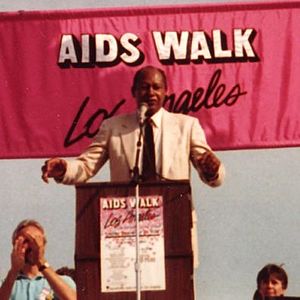
In 1969, Bradley first ran for mayor against the current mayor, Sam Yorty. Bradley had strong support from many groups. He was ahead in the first round of voting. However, Yorty won the election in the end. Yorty tried to make Bradley seem like a threat to the city. Many white voters became unsure about supporting Bradley. Four years later, in 1973, Bradley ran again and won. He became the Mayor of Los Angeles.
Mayor's Achievements
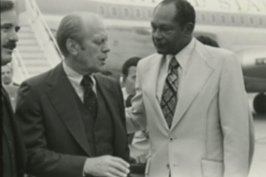
As mayor, Tom Bradley helped Los Angeles grow. He supported the creation of new business areas like Century City and Warner Center. He also worked hard to build Los Angeles's light rail system. This system helps people travel around the city. He also pushed for the expansion of Los Angeles International Airport. The Tom Bradley International Terminal at the airport is named after him.
Bradley served as mayor for 20 years. This was longer than any other mayor in Los Angeles history. He was offered a job in President Jimmy Carter's government but turned it down. In 1984, he was considered to be the Vice President candidate for Walter Mondale. Los Angeles hosted the 1984 Summer Olympics while he was mayor. In 1984, Los Angeles also became the second-largest city in the U.S. by population.
End of Mayoral Term
Tom Bradley believed that business success was good for the whole city. This idea was popular for most of his time as mayor. However, in his fourth term, people started to worry about traffic and pollution. In 1989, he was elected for a fifth term. But his support was starting to drop.
Other issues also affected his popularity. He changed his mind about an oil drilling project. He also did not strongly speak out against a minister whose speeches were seen as anti-Jewish by many. Tom Bradley decided not to run for a sixth term in 1993.
Running for Governor
Tom Bradley ran for Governor of California twice. He ran in 1982 and 1986. He lost both times to Republican George Deukmejian. He was the first African American to run for governor in California.
In 1982, the election was very close. Bradley was ahead in the polls before the election. Some news channels even said he won. But in the end, Bradley lost by about 100,000 votes. This close and unexpected loss led to the idea of the "Bradley effect". This is when voters might say they will vote for a black candidate but then vote for a white candidate. In 1986, Bradley lost to Deukmejian again by a larger amount.
Later Life and Passing
In March 1996, Tom Bradley had a heart attack. He had surgery for it. Later, he had a stroke, which made it hard for him to speak clearly. He passed away on September 29, 1998, at the age of 80. His body was displayed at the Los Angeles Convention Center for people to say goodbye. He was buried in Inglewood Park Cemetery.
Honors and Legacy
- In 1976, Bradley received an honorary law degree from Whittier College.
- In 1984, he was given the Olympic Order in silver.
- His mayoral papers are kept at UCLA.
- The Tom Bradley International Terminal at Los Angeles International Airport is named after him.
- The Civic Center/Tom Bradley Station on the Metro Rail's Red and Purple Line is also named in his honor.
See also


